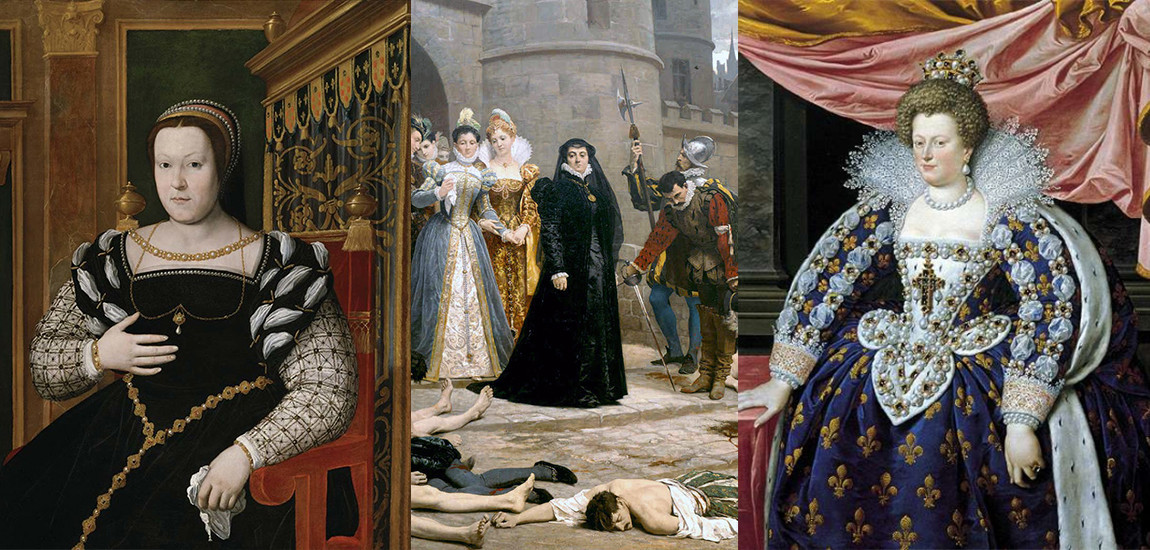
Caterina de Medici, a Florentine woman at the court of France
Daughter of Lorenzo di Piero de Medici, Duke of
Urbino, and nephew of Pope Leone X, Caterina de Medici could have only be
destined for great things.
Although she remained an orphan after her birth in 1519 and was placed in a
convent at the age of eight; thanks to the negotiations of his family she
succeeded in securing a future as a sovereign, when she was promised in
marriage to the second son of King Francesco I of France, Henry II.
At the age of 14 she left for France, bringing with her not only her dowry, but
also tailors, jewelers, perfum makers, a trusted astrologer and a large number
of cooks, among the best in Florence.
Coming from a family of bankers, plump, a bit ugly and with ball-shaped eyes
characteristic of the Medici family, Caterina was not welcomed with open arms
by the French court. Even the future king of France, Henry II, who was a
handsome young man, was disappointed by her looks, and their marriage was not a
happy one.
While Caterina had really fallen in love with Enrico, he neglected her,
reserving all his attentions for his lover, Diana of Poitiers.
Caterina strongly hated Diana, but she had to endure her presence all her life,
for her husband's sake.
Indeed, this was a difficult situation for her, because it took ten years
before she could give his husband an heir. Ten years during which she had to
endure court gossip about her alleged sterility. Unfortunately, even with the
arrival of the first heir, followed by eight other children, the situation did
not change for Caterina, who was always sidelined by Enrico, at that point deeply
in love with Diana.
The only real consolation for Caterina was food, on which she vented all her
sorrows. Not only did she love to eat, but she also had very refined tastes.
With the help of the Florentine chefs she had brought
with her to France, she managed to change French cuisine by first introducing
the use of olive oil and sauces, including the famous béchamel sauce.
The frittatata,
much loved by the Medici family, became the French omelettes, when Caterina brought this method of preparation of eggs
with vegetables with her.
She also imported the carabaccia,
the onion soup from Tuscany, which then became the soupe d’oignons in France.
Caterina also divided the savory dishes from the sweet
ones, which she loved so much. Her trusted baker, Pantanelli, created for her
in France choux pastry ("choux" means cabbage in French, and once
cooked, the bignet resembled brussels
sprouts). The French loved this preparation a lot, and they used it for the
famous eclaires.
Even more famous, became the sorbets of the Florentine
Ruggeri, delicious desserts made of "ice with sweetened and perfumed water".
However, the real revolution on the French tables, was
brought by the introduction of the use of the fork.
At the time, even at court in France, people still ate with their hands. To
eat in a cleaner way, Caterina made mandatory the use of a fork, that had been
used in Florence for some time.
Rumor has it, that it was not easy to get her husband and
the French nobles accustomed to this new tool, which they initially used in a
clumsy way, leaning over the plate with their whole body to bring the bite to
the mouth.
But Caterina did not limit herself to bringing new uses and costumes to the
table.
Over the years, in an attempt to please her husband, she
introduced various innovations in the women’s fashion world as well.
On her arrival in France, she felt insecure and did not
want her short stature to make her look ridiculous next to Henry on their
wedding day. So, with the help of a Florentine shoe maker, she designed the
first modern stilettos, an invention that, as we know, revolutionized the world
of fashion forever.
Caterina loved Enrico so much, that after his death,
following an accident in a tournament, she decided to stay in mourning clothes for
life.
Even then, she could not give up trying to look more
beautiful. Therefore, she decided that she
would not wear white, the color of mourning for the royal, because it did not flatter
her figure at all. Instead, she preferred black, the color that made her look
thinner and that she felt comfortable wearing.
Another novelty, introduced by Caterina to the French
court in the sixteenth century, was the use of the corset.
Her passion for food led her to put on a lot of weight, but she longed to look
slimmer and more beautiful in the eyes of her husband. So he decided to use a
corset under her clothes. This additional garment in the female wardrobe was
quickly received by all French women and remained in use for centuries.
It does not end here, Caterina enriched the ladies' wardrobe with another
precious item of clothing.
She was in fact able to promote the use of underpants among the ladies, because
according to her, riding a horse without this important undergarment was really
inconvenient and unbecoming!
Although history tends to recall her as an austere, blood thirty woman, perhaps
implicated in the massacre of the night of Saint Bartholomew; it is now clear
how important the legacy left by Catherine de Medici to posterity is.
Surely, we can only be grateful to the woman who made ice cream famous!



